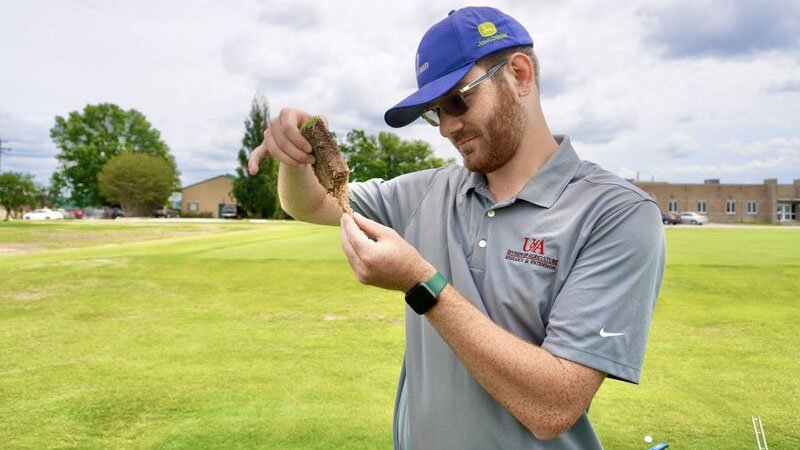Winter can be a stressful period for warm-season turf on golf courses and even athletic fields.
As winter approaches, warm-season grasses go into dormancy to conserve energy. According to the book Turfgrass: Science and Culture by James Beard, Ph.D. (Pearson, 1972, 672 pages) "warm-season turf turns brown in winter because as light intensity increases, the rate of breakdown of chlorophyll increases and the total content of chlorophyll in the leaf decreases. As temperatures decrease, the growth rate of the plant decreases, which includes the production of chlorophyll. When light intensity is high and temperatures are low enough, the rate of chlorophyll breakdown exceeds the rate of chlorophyll synthesis and the turfgrass plant leaves turn brown." In other words, chlorophyll breaks down faster than the plant can produce it.
Managing fertility, moisture and mowing practices are critical in setting up turf to withstand winter damage and help ensure a successful spring green-up.
A recent study conducted by researchers in the Southeast has yielded tips for preparing warm-season turf for winter and minimizing the chances for winterkill damage. And some of their findings might come as a surprise.
It is important to try to get the plant as vigorous, healthy and happy as possible. The best fungicide is healthy turfgrass.
The study, conducted on sites in Arkansas, Maryland and Virginia, compared Bermudagrass plots that were fertilized with late-season nitrogen, mowed, irrigated and treated with wetting agents with untreated control plots. The study showed that raising mowing heights and application of more nitrogen in the late summer/early fall provided the greatest green color for hybrid Bermudagrass with no negative effects on winter survival.
 The study was conducted on a handful of Bermudagrass varieties, including Tahoma 31, Latitude 36, Tufcote and Tifway 419, from 2019 to 2023 at outdoor and indoor locations by researchers in Arkansas, Maryland and Virginia. Results of the study were published in the August 2024 issue of Crop, Forage and Turfgrass Management. Comprising the research team were Michael Battaglia, Jordan Booth, Ph.D., Eric DeBoer, Ph.D., Joseph Doherty, Ph.D., Wendell Hutchens, Ph.D. (right), David McCall, Ph.D., and Joseph Roberts, Ph.D.
The study was conducted on a handful of Bermudagrass varieties, including Tahoma 31, Latitude 36, Tufcote and Tifway 419, from 2019 to 2023 at outdoor and indoor locations by researchers in Arkansas, Maryland and Virginia. Results of the study were published in the August 2024 issue of Crop, Forage and Turfgrass Management. Comprising the research team were Michael Battaglia, Jordan Booth, Ph.D., Eric DeBoer, Ph.D., Joseph Doherty, Ph.D., Wendell Hutchens, Ph.D. (right), David McCall, Ph.D., and Joseph Roberts, Ph.D.
Based on previous research, late-season nitrogen applications were not recommended with the thought being it would result in a flush of growth with all the nutrients going into the leaf and not into the roots. This project, however, showed that use of a slow-release nitrogen fertilizer either resulted in no impact or helped improve root health.
"We weren't trying to prove anybody wrong. Some data says nitrogen in fall actually helps increase winterkill," said study co-author Wendell Hutchens, Ph.D., of the University of Arkansas. "There are conflicting reports, and we wanted to do the research to answer that question."
Hutchens will present a webinar on TurfNet titled Preventing winterkill in warm-season turf on Nov. 19. Click here to register for that event.

Applications of a 44-0-0 slow-release fertilizer were applied at varying intervals in early to late summer in each year of the study at rates of 2 pounds and 4 pounds per 1,000 square feet on plots mowed at 0.5 inches, 0.8 inches and 1 inch.
"Conventional wisdom has been not to apply nitrogen in fall," Hutchens said. "But slow-release fertilizer didn't seem to hurt it, and sometimes was beneficial."
Because of mild winter conditions throughout the study, samples from the test plots were placed into a freeze chamber to simulate harsh winter conditions. Chamber conditions were 5 degrees Fahrenheit for five hours, and 15.8 degrees for two, four, six or eight hours.
Results of the study showed that late-season applications of slow-release nitrogen can help retain fall color without compromising cold hardiness through winter. Those findings were consistent with other studies conducted by Mike Goatley, Ph.D., at Virginia Tech, Mike Richardson, Ph.D., at Arkansas and Gregg Munshaw, Ph.D., at Mississippi State.
The study also showed that fall mowing height at 0.5 inches increased green color retention going into dormancy and increased spring green-up. No negative effects associated with adjusting mowing heights or schedules were noted in the study.
Plots were irrigated to levels less than 15 percent volumetric water content and more than 19 percent VWC. Data from the multi-site study showed that irrigation at the higher rate and applications of wetting agents before short-term freeze events reduced winter injury or winter winterkill.
We weren't trying to prove anybody wrong. Some data says nitrogen in fall actually helps increase winterkill. There are conflicting reports, and we wanted to do the research to answer that question.
Those findings, which are contrary to some studies conducted previously, leading the research time to conclude that more research on the subject is needed. Hutchens reminds turf managers that areas with chronic agronomic issues, including poor drainage and excessive shade, should be addressed to prevent winter damage.
Many golf courses throughout the transition zone will open when conditions are conducive for golf, and too much play on dormant turf also can lead to plant stress.
"Areas where shade is an issue or are chronically wet are more prone to winter kill," Hutchens said. "Certain areas die every year, because the turf doesn't have time to mature."
Hutchens said undue stress can be minimized by taking measures such as prohibiting single-rider golf cars, managing fairway entry and exit points.
"It is important to try to get the plant as vigorous, healthy and happy as possible," Hutchens said. "The best fungicide is healthy turfgrass."

